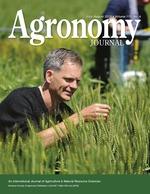View Item
- xmlui.general.dspace_homeCentros Regionales y EEAsCentro Regional Santa FeEEA OliverosArtículos científicosxmlui.ArtifactBrowser.ItemViewer.trail
- DSpace Home
- Centros Regionales y EEAs
- Centro Regional Santa Fe
- EEA Oliveros
- Artículos científicos
- View Item
New insights into soybean biological nitrogen fixation
Abstract
Soybean biological N2 fixation (BNF) relationships with fertilizer N and yield response have been comprehensively reviewed in the scientific literature. However, the study of the N-gap between N uptake and N supplied by N2 fixation, and the partial N balance (fixed N in aboveground biomass – N seeds) needs further investigation. Therefore, the goals of this synthesis–analysis were to (i) quantify seed production per unit of fixed N under different amounts
[ver mas...]
Soybean biological N2 fixation (BNF) relationships with fertilizer N and yield response have been comprehensively reviewed in the scientific literature. However, the study of the N-gap between N uptake and N supplied by N2 fixation, and the partial N balance (fixed N in aboveground biomass – N seeds) needs further investigation. Therefore, the goals of this synthesis–analysis were to (i) quantify seed production per unit of fixed N under different amounts of N derived from the atmosphere (NDFA, %), (ii) study the N-gap and explore limitations of N2 fixation (kg ha–1) for satisfying plant N demand, and (iii) calculate a partial N balance for soybean and determine its relationship with the N2 fixation process. Data was gathered from 1955 through 2016 using studies reporting BNF, seed yield, and plant N uptake (n = 733 data points). The main outcomes of this review were (i) as NDFA increased, seed production per N2 fixation decreased (from 0.033 to 0.017 Mg yield kg–1 N from low, 28%, to high, 80%, NDFA); (ii) N-gap increased faster when NDFA values were above 80% and after plant N content was above 370 kg N ha–1 suggesting that the crop needs additional N for coping yield potential; and (iii) when excluding roots, the partial N balance calculation revealed negative values across all NDFA levels. Future studies should consider a holistic approach to quantify the contribution of BNF in overall N cycling, including N contribution from roots, and to better understand the soil × plant × rhizobia interactions.
[Cerrar]

Author
Ciampitti, Ignacio A.;
Salvagiotti, Fernando;
Fuente
Agronomy Journal 110 (4) : 1185-1196 (2018)
Date
2018-08
Editorial
American Society of Agronomy
ISSN
0002-1962
1435-0645
1435-0645
Formato
pdf
Tipo de documento
artículo
Palabras Claves
Derechos de acceso
Abierto
 Excepto donde se diga explicitamente, este item se publica bajo la siguiente descripción: Creative Commons Attribution-NonCommercial-ShareAlike 2.5 Unported (CC BY-NC-SA 2.5)
Excepto donde se diga explicitamente, este item se publica bajo la siguiente descripción: Creative Commons Attribution-NonCommercial-ShareAlike 2.5 Unported (CC BY-NC-SA 2.5)


